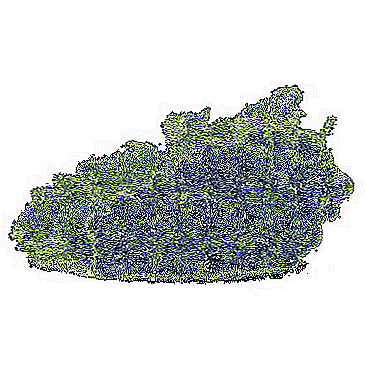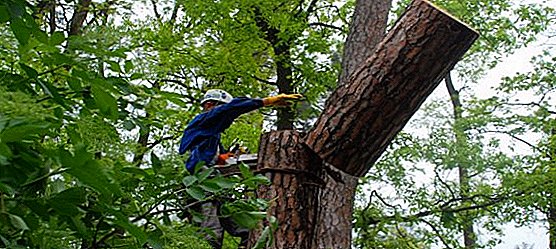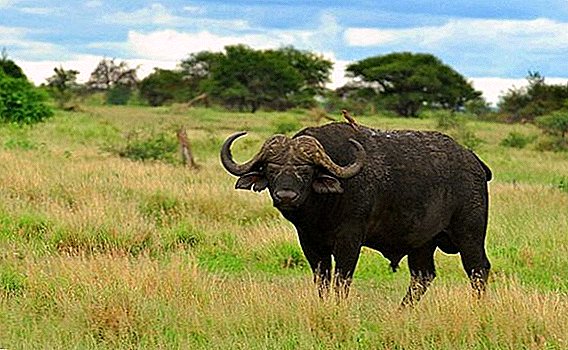 Black buffalo can be safely called the largest representative among all the bulls.
Black buffalo can be safely called the largest representative among all the bulls.
He has a memorable appearance, specific character, can be both dangerous and vulnerable.
In our article we will describe in detail about this massive and unusual animal.
Appearance
The weight of a male African bull ranges from 950 to 1200 kg. The female has a slightly lower weight - about 750 kg.
Important! The African buffalo is an aggressive and unpredictable animal. If you encounter a bull, do not make sudden movements, and if possible slowly move away from it, not losing sight of.
The horns of an animal are very similar in shape to a sporting bow for shooting. Their diameter is about 35 cm. At first they are bred to the sides, after which they are bent down and bent up. As a result, a powerful shield is formed, which allows one to call the forehead of a bull the strongest place on its body.  The height of an adult bull can be about 2 m. The average thickness of the skin is more than 2 cm. Due to this layer, external factors are not afraid of the animal. On the surface of the skin there is a rough coat of dark color - it can be gray or black. Some females may have a red coat color.
The height of an adult bull can be about 2 m. The average thickness of the skin is more than 2 cm. Due to this layer, external factors are not afraid of the animal. On the surface of the skin there is a rough coat of dark color - it can be gray or black. Some females may have a red coat color.
The bull has closely spaced eyes to the frontal bone, often tears. Unfortunately, for this reason, various parasites, insects and their eggs appear on the damp hair near the eyes.
The African bull has a good sense of smell, but he cannot boast with his eyesight.  The head is slightly lower than the whole body, its upper part is flush with the lower line of the back. The animal has powerful front legs, the rear ones are slightly weaker.
The head is slightly lower than the whole body, its upper part is flush with the lower line of the back. The animal has powerful front legs, the rear ones are slightly weaker.
Subspecies
Today in nature you can find the following subspecies of the African bull:
- Cape;
- Nile;
- dwarf (red);
- mountain;
- Sudanese.




Many years ago the number of subspecies reached 90, but only those listed above have survived to our times.
Learn more about the types of buffaloes, in particular, the Asian buffalo.
Area of distribution and habitat
Most often formidable bulls are found in warm African areas: forests, savannas, mountains, south of the Sahara. They prefer areas in which there are extensive water sources and pastures with thick grass. They do not like to settle near people.
The distribution area for different subspecies is different. For example, dwarf buffaloes choose wooded areas of West and Central Africa. Sudanese subspecies can be found in the west of the continent, more precisely - in Cameroon.
Did you know? The African buffalo is one of the five most dangerous animals and is on par with lions, leopards, rhinos and elephants.
The savannas, located in the east and south of the continent, are more suitable for the Cape gobies, and the Nile subspecies chose Sudan, Ethiopia, Congo, Uganda, Central Africa for their habitats. Mountain subspecies are found in eastern Africa.  In addition, the black bull can be considered in the reserve or the zoo.
In addition, the black bull can be considered in the reserve or the zoo.
See also: Only the most interesting about cows
Lifestyle, temper and habits
Black bulls have a rather aggressive disposition and behave very wary, they live in groups. If animals live in open space, the group is about 30 heads, if in the forest - up to 10. When drought occurs, the groups join together. Such a herd can number several hundred individuals.
There are several types of herds:
- Mixed. Includes adult bulls, females and calves. The closer to the south the herd lives, the more young animals there are.
- Old. Such a herd usually consists only of old bulls, whose age is more than 12 years.
- Young. The composition of this group - buffalo at the age of 4-5 years.
Herd has a clear hierarchy. Old buffaloes are usually located along its perimeter, which protect the group and inform the individuals about the threat. As soon as there is any danger, the animals immediately tightly lump together, thereby protecting the females and calves. In emergency situations, bulls are able to run at speeds of up to 57 km / h.  African buffalo are predominantly nocturnal. At night, they graze, and during the day, when the air temperature is quite high, animals move into shady thickets or coastal mud.
African buffalo are predominantly nocturnal. At night, they graze, and during the day, when the air temperature is quite high, animals move into shady thickets or coastal mud.
Important! About 16% of black buffaloes are carriers of cattle tuberculosis, so farmers need to ensure that the bulls do not come close to domestic animals.
It is worth noting that the African bulls are not too fond of the neighborhood with other animals and birds, with the exception of only dragging - birds, which are also called buffalo starlings. These birds are very attached to these huge animals, from the skins of which they get their food - insects and their larvae.  During the "rut" the males can fight each other: they attack each other, they can break the horns, but the black buffalo will never kill the victim.
During the "rut" the males can fight each other: they attack each other, they can break the horns, but the black buffalo will never kill the victim.
What eat in the wild
The basis of the food of wild buffalo is vegetable food. Animals prefer certain types of herbs that they eat throughout the year. Even if there is a huge amount of greenery around, black bulls will go to look for their favorite herbs. They choose juicy, rich in fiber and plants growing in the coastal areas. But the shrubs they do not like - they make up only 5% of the diet of the animal.  In 24 hours the African buffalo should eat herbs at least 2% of its mass. If the percentage is less, the bull will rapidly lose weight. In addition, buffalo need to drink plenty of water - 30-40 liters per day.
In 24 hours the African buffalo should eat herbs at least 2% of its mass. If the percentage is less, the bull will rapidly lose weight. In addition, buffalo need to drink plenty of water - 30-40 liters per day.
It is interesting to read about the representatives of wild bulls: zebu, watusi.
Breeding
Females become sexually mature at the age of 3 years, males - at 5 years. From March to the last days of May the animals last for the mating season. Males at this time are distinguished by ferocity, but this behavior has its own explanation - they need to compete with other bulls for the female.
Buffalo's gestation period is 10-11 months. At birth, the weight of the calf can vary from 40 to 60 kg. Every day its weight increases, since in 24 hours it absorbs almost 5 liters of milk. At the age of 1 month, young animals can already be called independent, they begin to eat plant food, like adults. In the wild, African buffaloes live 15-16 years, and those bulls that are found in reserves and are constantly under the supervision of people can live to 30 years. 
Population and conservation status
Black bulls, like all animals, have some enemies. In addition, a man also plays an important role in the life of buffaloes.
Natural enemies in nature
Living in the wild, African buffaloes have few enemies. Most often they suffer from lions, but these predatory animals are not always able to cope with the bulls. The buffalo begins to use its horns, and it is a rather dangerous weapon that can easily rip a lion's belly. It is for this reason that lions prefer to attack calves who are fighting off the herd. However, if one of the buffaloes notice an attack on the calf, the whole herd will immediately rush to help the baby. Calves may also be attacked. leopards, cheetahs and spotted hyenas.
In addition to large natural enemies, inconvenience to black buffalo is delivered by small blood-sucking parasites. And although animals have a thick skin, the larvae and ticks still ruin their lives. 
Man and buffalo
Unfortunately, a person can have a negative impact on the buffalo population. For example, in the Serengeti, where many of these animals lived, from 1969 to 1990 the number of individuals decreased from 65 to 16 thousand due to poaching. In our time, the situation, fortunately, has stabilized.
Did you know? All black buffaloes suffer from myopia, but poor eyesight does not prevent them from feeling the approach of the enemy, as they have excellent hearing and smell.
Usually, bulls try to settle away from humans, but in some regions of Africa they may end up near people's homes. In such situations, a person simply destroys animals, treating them as pests that take down hedges.
Video: African buffalo
African black buffalo is a powerful animal that nowadays needs human protection. It is necessary to strive for the implementation of environmental protection measures so that the population of these strong animals does not cease to exist.












